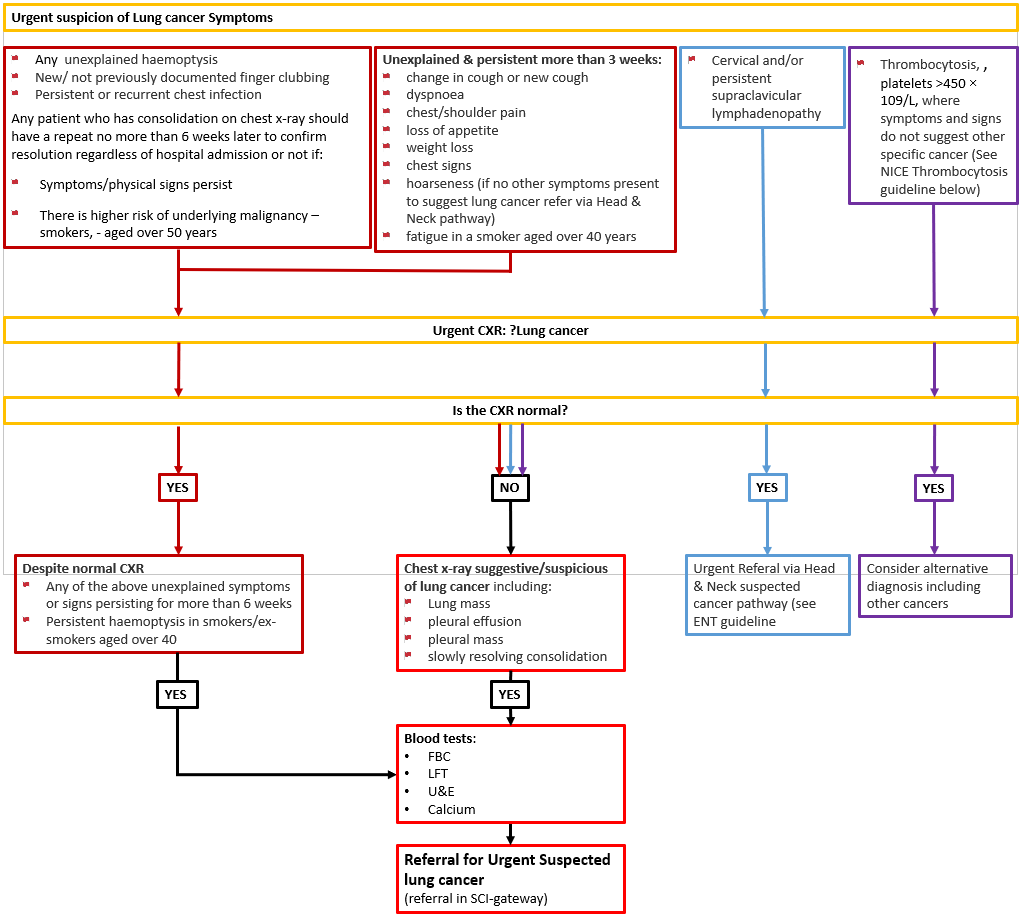
NICE Thrombocytosis guideline https://cks.nice.org.uk/topics/platelets-abnormal-counts-cancer/

Lung cancer is a malignant tumour which grows in the tissues of the lung. It is the third most common cancer in the UK with an estimated life time risk of developing lung cancer being 7% for females and 8% for males.
Lung cancer is more commonly diagnosed in people aged 75 and over and is often diagnosed late with 46.1% of new lung cancers in England being stage 4 at diagnosis in 2018.
While over 90% of patients are symptomatic at presentation, symptoms can be vague and similar to other conditions more common in primary care.
This guideline is aimed at primary care clinicians to provide guidance regarding when to suspect lung cancer, what investigations to perform and when to make a referral to the urgent suspected lung cancer clinic.

NICE Thrombocytosis guideline https://cks.nice.org.uk/topics/platelets-abnormal-counts-cancer/
Patients presenting with any of the following red flag symptoms/signs for lung cancer should undergo an urgent chest X-ray.
Any patient who has consolidation on chest x-ray should have a repeat no more than 6 weeks later to confirm resolution regardless of hospital admission or not if:
Imaging
Blood tests
As this is a timed pathway CXR images and blood results must be available at the point of referral in order for the referral to be accepted and progressed appropriately. If they are not then the referral will be returned.
Patients meeting any of the following criteria should be referred to the urgent suspected lung cancer clinic.
Chest x-ray suggestive/suspicious of lung cancer including:
Despite normal CXR
Alternative referral
Scottish Referral guidelines for suspected lung cancer - http://www.cancerreferral.scot.nhs.uk/lung-cancer/?alttemplate=guideline
Interpreting platelet results | Diagnosis | Platelets - abnormal counts and cancer | CKS | NICE. Revised 2021. Accessed March 3, 2022. https://cks.nice.org.uk/topics/platelets-abnormal-counts-cancer/diagnosis/interpreting-platelet-results/
Coronavirus (COVID-19): management of urgent suspicion of lung cancer referrals https://www.gov.scot/publications/coronavirus-covid-19-management-of-urgent-suspicion-of-lung-cancer-referrals
Symptoms suggestive of lung and pleural cancers | Diagnosis | Lung and pleural cancers - recognition and referral | CKS | NICE. Accessed March 3, 2022. https://cks.nice.org.uk/topics/lung-pleural-cancers-recognition-referral/diagnosis/symptoms-suggestive-of-lung-pleural-cancers/
Pneumonia Adults | British Thoracic Society | Better lung health for all. 2015. Accessed December 15, 2021. https://www.brit-thoracic.org.uk/quality-improvement/guidelines/pneumonia-adults/
Contact the Respiratory Team
For any querys or concerns contact the respiratory consultants for advice: nhsh.raigmorerespiratory@nhs.scot
Pneumonia Adults | British Thoracic Society | Better lung health for all. 2015. Accessed December 15, 2021.https://www.brit-thoracic.org.uk/quality-improvement/guidelines/pneumonia-adults/
Interpreting platelet results | Diagnosis | Platelets - abnormal counts and cancer | CKS | NICE. Revised 2021. Accessed March 3, 2022.https://cks.nice.org.uk/topics/platelets-abnormal-counts-cancer/diagnosis/interpreting-platelet-results/
| Abbreviation | Meaning |
| CXR | chest xray |
| ENT | ear, nose and throat |
| FBC | full blood count |
| U&E | urea and electrolytes |
| LFT | liver function tests |